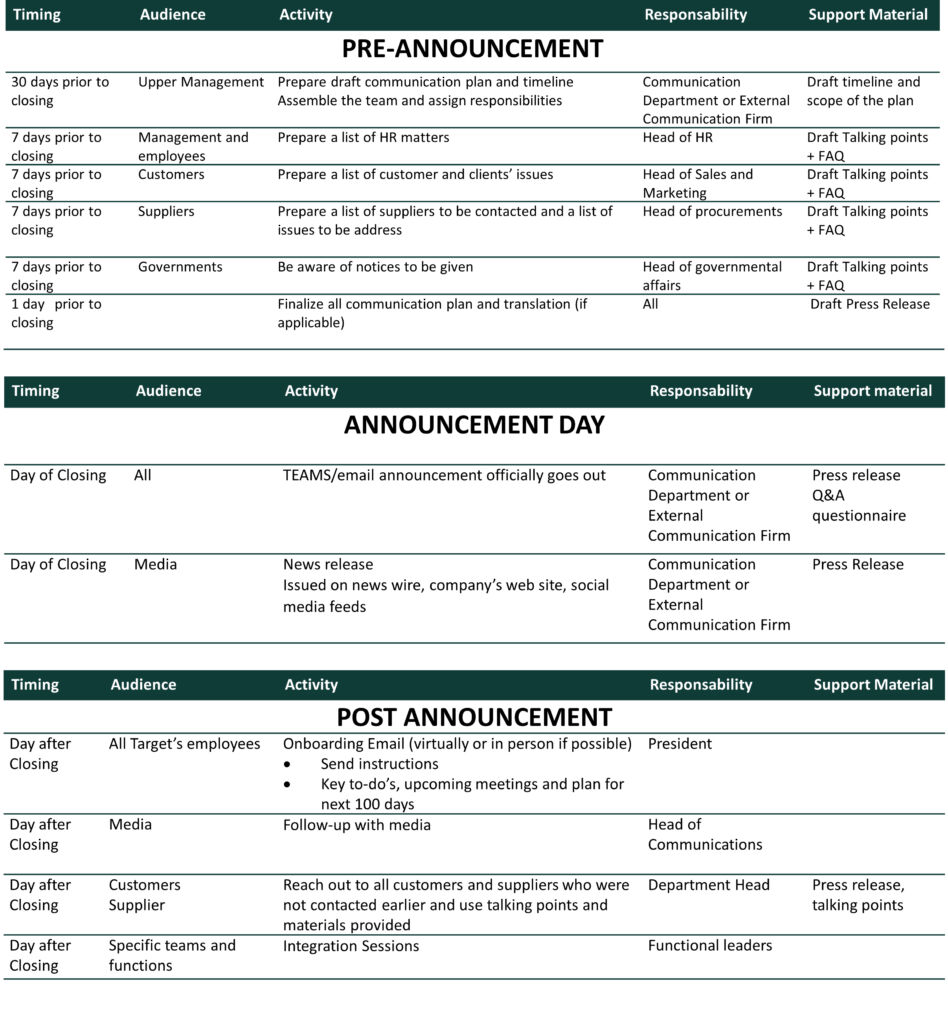Communication Plan
In an M&A transaction, controlling the message is key in order to maximize the benefits of the announcement and minimize the insecurity surrounding the change of control. To successfully communicate a transaction, companies must establish a detailed and strategic communication plan.
Why Have a Transaction Communication Plan?
PURPOSE OF THE COMMUNICATION PLAN
COMMUNICATION PLAN OBJECTIVES
- To get the buy-in of all stakeholders;
- To show the strategic fit of the transaction for all parties involved;
- To demonstrate the benefits and potential upside for the employees, clients and suppliers;
- Use the occasion to enhance the company’s visibility.
COMMUNICATION DELIVERABLES
- Typical Q&A covered
- Sample Press Release
- Timeline
- Social media postings
Communication Plan Best Practice
- A contact person should be named at the beginning of the process. All media inquiries should go through that person. To control the message, no one else should talk to the media.
- Transparency is always better. You won’t have to remember what you said.
- A good communication plan does not have to be expensive but a budget should be established at the outset to avoid surprises.
- At the end, a post-mortem should be done i.e., what has worked well, what should have been done differently and what have we learned?
Who Are the Stakeholders?
Stakeholders vary from transaction to transaction. The typical list would include the following parties that need to be informed:
Internal
- Senior Management
- Employees of both the acquiring company and the acquired company
External
- Customers
- Suppliers
- Distributors
- Franchisees
- Financial Partners
- Governments (Municipal, Provincial, Federal)
- General public
- Public shareholders (if applicable)
- Media (if applicable)
Typical Questions & Answers
The following is a sample of questions that might be asked by various parties or that may need to be addressed in the form of a Q&A questionnaire ahead of the announcement by target audiences.
General
In a press release, we usually address the 5 Ws: who, what, when, where, why and how.
- Who is the purchaser?
- What is being acquired?
- When is (or did) the transaction taking place?
- Where are the acquirer and acquiree located?
- Why are we buying?
- How will the deal impact customers, suppliers and employees?
Management and Employees
- Will I still have a job?
- Will my compensation change?
- Will my benefits change?
- Who will I report to?
- Will I have to relocate?
- Will I still have the same teammates?
- Will my title or job responsibilities change?
- Will our culture change?
- Will our work process change?
- Will the salespeople keep their existing territories and customer bases?
- Will we have career opportunities at other locations now?
- Will there be a severance package if I lose my job?
- Whom should we contact if we have questions?
- What are my options if I decide not to work for the new owner?
- What should I do if someone from the media calls to ask about the transaction?
Customers
- How will this change in ownership impact me?
- What do I stand to gain from the deal? What are the benefits for me?
- Will my warranties still be in effect?
- Will inventory levels remain the same?
- Will the quote you gave me still be honoured?
- Will there be changes to payment remittance methods?
- Will there be any staffing changes that might affect me?
- Whom do I call if I have a problem or concern?
Suppliers
- Where and to whom should invoices be sent now?
- Are the contracts/purchase orders we have in place still valid? If so, for how long?
- Will policies regarding how you select vendors/suppliers change?
- Will we be required to ship materials to a different location?
- Will my company be required to seek any new quality certifications?
- Will we still be dealing with the same purchasing agent(s)?
- Do you expect the volume that you have been ordering to increase or decrease?
- How much notice will we be given if you decide to cancel our service?
Timeline
The key to a successful communication plan is “planning”. The following template list pre-announcement, announcement day and post announcement activities that need to be contemplated with supporting materials.

Multi-channel Communications
Several platforms can be used to share the communication plan. Amongst them are:
- Company’s website
- Company’s blog
- YouTube
- RSS Feeds
- Newsletter
- Media list
Please click here for a copy of the above in PDF presentation format.
Stay informed
Subscribe to our newsletters to stay on top of industry news, develop your knowledge and receive relevant, real-time advice.